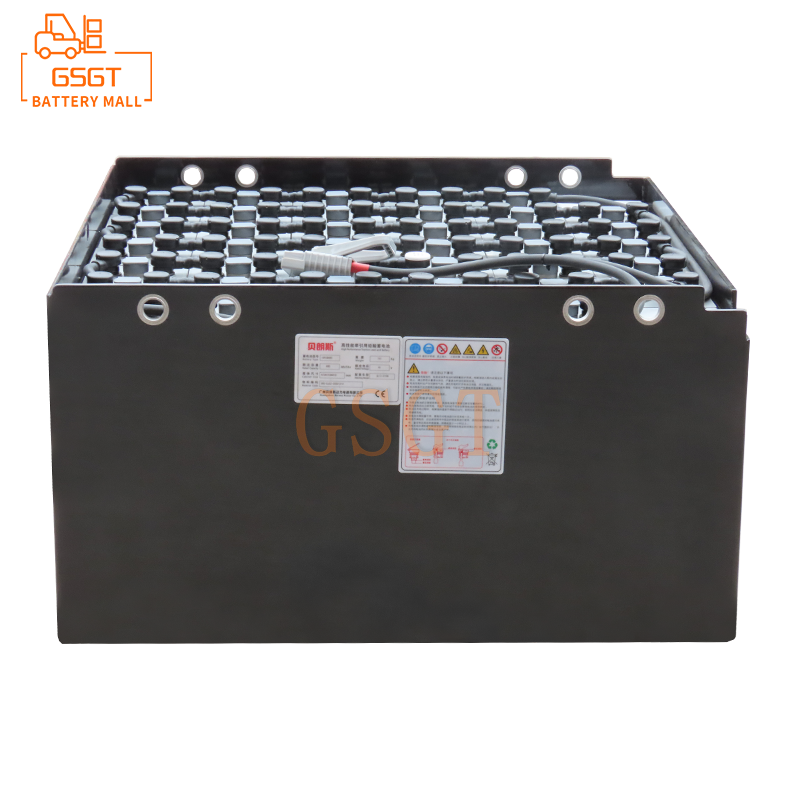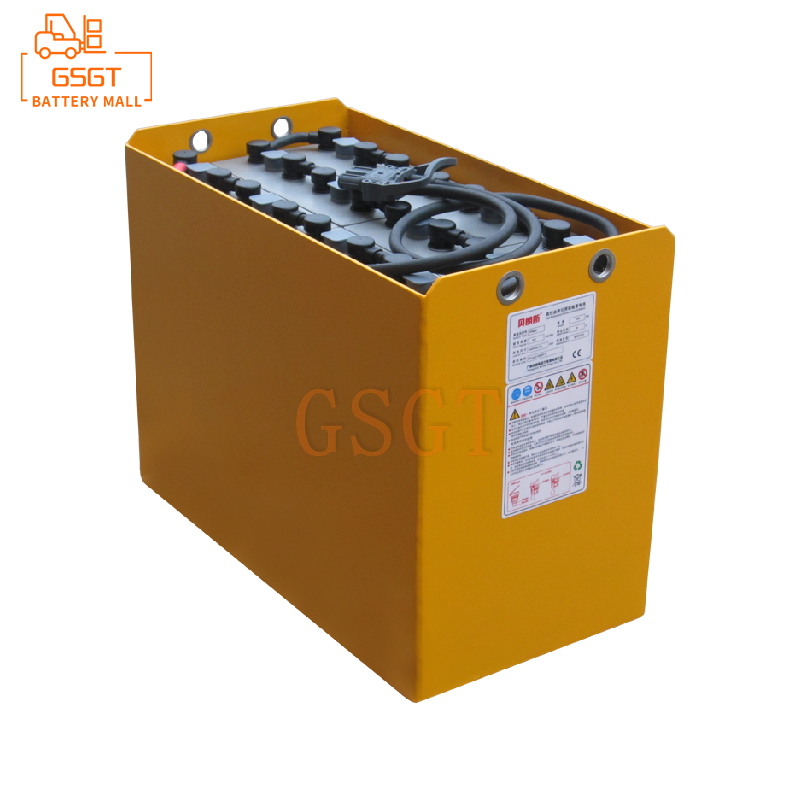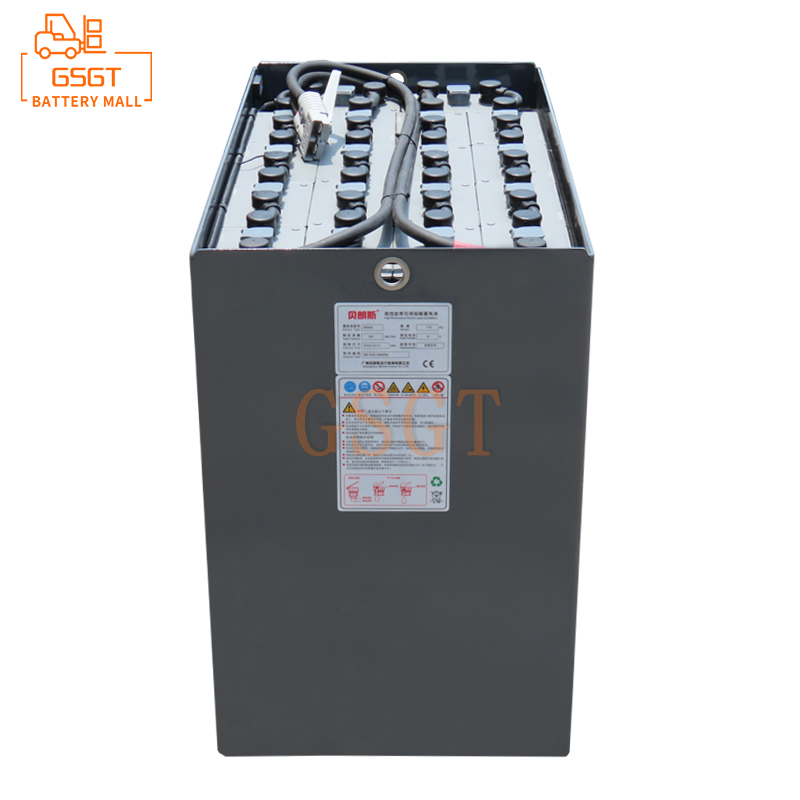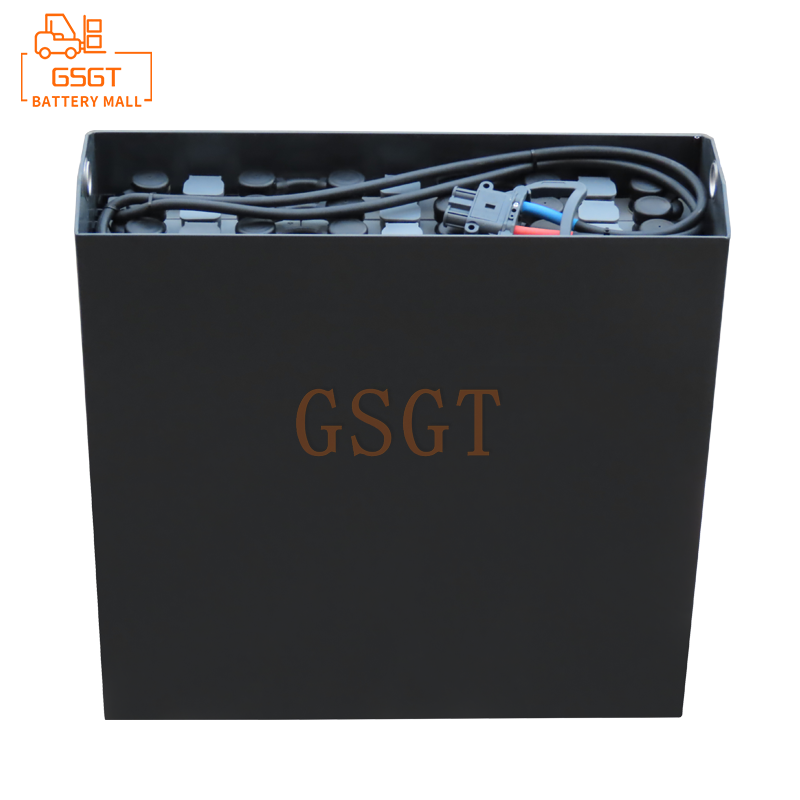Time:2025-06-17 10:01:17
Browse:577
Introduction
Forklifts, as indispensable handling equipment in modern logistics and industrial production, the performance of their power sources directly affects work efficiency and operating costs. Lead-acid batteries have been widely used in the forklift field due to their advantages such as mature technology, low cost and good high-rate discharge performance. A thorough understanding of the charging and discharging cycle principles and performance indicators of forklift lead-acid batteries is of great significance for optimizing the use of forklifts, extending battery life and improving overall operational efficiency.
The structure and composition of lead-acid batteries for forklifts
Lead-acid batteries are mainly composed of positive plates, negative plates, electrolyte, separators, battery cases, battery covers, terminals and liquid injection covers, etc. The positive plate usually adopts a tubular structure, and its active substance is lead dioxide. The negative plate is of plate structure and the active material is spongy lead. The electrolyte is a dilute sulfuric acid solution prepared by mixing sulfuric acid and water in a certain proportion, which plays a key role in the electrochemical reaction of the battery. The separator is used to prevent short circuits between the positive and negative plates, and at the same time allows ions to pass between the plates, promoting the progress of electrochemical reactions. Battery compartments and battery covers are generally made of acid-resistant, corrosion-resistant materials with certain mechanical strength, serving to accommodate and protect the internal components. The terminal post is used to connect the external circuit to achieve the transmission of electrical energy between the battery and the forklift's electrical system, while the liquid filling cover is used to add electrolyte or replenish distilled water.
The principle of charge and discharge cycles
Chemical reactions during the discharge process
When the lead-acid battery of a forklift is connected to an external circuit for discharge, complex electrochemical reactions occur inside the battery. At the negative plate, lead reacts with sulfate ions in the electrolyte to form lead sulfate and release two electrons. At the positive plate, lead dioxide reacts with electrons and hydrogen ions under the action of sulfuric acid, also generating lead sulfate and water.
As the discharge continues, the active substances on the positive and negative plates gradually transform into lead sulfate. The sulfuric acid in the electrolyte is constantly consumed, and its concentration gradually decreases, resulting in a decrease in the density of the electrolyte and a corresponding reduction in the electromotive force of the battery. Meanwhile, due to the relatively high resistance of lead sulfate, the internal resistance of the battery gradually increases, which causes the output voltage of the battery to gradually decrease during the discharge process. When the voltage drops to a certain extent and reaches the terminal voltage of the battery, the discharge process ends.
The chemical reaction during the charging process
The charging process is the reverse reaction of the discharging process. When an external DC power supply is applied to charge the lead-acid battery of a forklift, under the effect of the power supply, the current flows into the battery from the positive terminal and out from the negative terminal. At the positive plate, lead sulfate reacts with water under the action of the charging current, regenerating lead dioxide and releasing sulfate ions and hydrogen ions. At the negative plate, lead sulfate gains electrons and is reduced to lead, while sulfate ions are produced.
As the charging proceeds, the lead sulfate on the positive and negative plates is gradually reduced to its original active material. The concentration of sulfuric acid in the electrolyte keeps increasing, the density of the electrolyte rises, and the electromotive force of the battery gradually returns to its initial value. When almost all the lead sulfate on the positive and negative plates is reduced and the density of the electrolyte and the battery voltage reach stable values, the charging process is basically completed. In the later stage of charging, due to the electrolytic effect of water, oxygen is produced on the positive plate and hydrogen on the negative plate. This is also the reason why lead-acid batteries need to pay attention to ventilation during the charging process.
Reversibility and loss in charge and discharge cycles
The charging and discharging process of lead-acid batteries is theoretically reversible, that is, chemical energy is converted into electrical energy through discharging, and then electrical energy is converted back into chemical energy for storage through charging. However, during the actual charge and discharge cycles, due to the influence of various factors, the battery cannot fully achieve the ideal reversible reaction and will inevitably suffer some losses. In addition, internal side reactions of the battery, such as self-discharge, will cause the battery to consume power slowly even when it is not connected to an external load, which will also have a negative impact on the battery's performance and service life. Meanwhile, if the heat generated during the charging process cannot be dissipated in time, it will cause the battery temperature to rise, accelerate the chemical reactions inside the battery, and further increase the battery's wear and tear. To reduce these losses and extend the service life of the battery, when using forklift lead-acid batteries, it is necessary to adopt reasonable charging and discharging strategies and effective maintenance measures.
Performance index
Capacity
Rated capacity
Rated capacity refers to the amount of electricity that a forklift lead-acid battery can release under specified discharge conditions, usually expressed in ampere-hours (Ah). It is an important indicator for measuring the battery's ability to store electrical energy. The size of the rated capacity mainly depends on factors such as the area of the internal plates of the battery, the quality of the active material, and the concentration of the electrolyte. The larger the area of the plates and the more active substances there are, the greater the amount of electricity the battery can store, and the corresponding rated capacity will be higher.
Actual capacity
Actual capacity refers to the amount of electricity released by the lead-acid battery of a forklift under specific discharge conditions during actual use. The actual capacity is affected by various factors and there is a certain difference from the rated capacity. The magnitude of the discharge current has a significant impact on the actual capacity. Generally speaking, the larger the discharge current, the lower the actual capacity of the battery. This is because when a large current is discharged, the rate of chemical reactions inside the battery increases, causing a large amount of lead sulfate to rapidly form on the surface of the plates. These lead sulfate blocks the micro-pores of the plates, hindering the full contact between the electrolyte and the active substance, thus preventing the electrochemical reaction from proceeding fully and reducing the actual capacity of the battery. In addition, temperature also has a significant impact on the actual capacity of batteries. In a low-temperature environment, the viscosity of the electrolyte increases, the ion diffusion rate slows down, the internal resistance of the battery increases, resulting in a decrease in the electrochemical reaction rate and a significant reduction in the actual capacity of the battery. In high-temperature environments, although the diffusion rate of ions increases, the side reactions inside the battery intensify, and the loss of active substances speeds up, which also affects the actual capacity of the battery. Therefore, under different usage environments and working conditions, the actual capacity of forklift lead-acid batteries will vary.
Discharge rate
Discharge rate refers to the rate at which a battery discharges, usually expressed by time rate or current rate. Time rate refers to the time it takes for a battery to discharge to the terminal voltage under certain discharge conditions, such as 5-hour rate, 10-hour rate, etc. Different discharge rates have a significant impact on the capacity and performance of forklift lead-acid batteries. As the discharge rate increases, the actual discharge capacity of the battery will decrease. This is because at a high discharge rate, the polarization phenomenon inside the battery intensifies, causing the terminal voltage of the battery to drop more rapidly and reach the terminal voltage prematurely, thus preventing the battery from releasing its full rated capacity. Therefore, in the actual use of forklifts, the appropriate discharge rate should be reasonably selected based on the working load and operating conditions to fully leverage the performance of the battery.
Cycle life
Cycle life refers to the number of charge and discharge cycles that a forklift lead-acid battery can undergo under certain charge and discharge conditions until the battery capacity drops to the specified terminal value. Cycle life is an important indicator for measuring the durability and reliability of batteries, which is directly related to the battery's service life and replacement cost. There are numerous factors affecting the cycle life of lead-acid batteries in forklifts. First of all, the depth of discharge has a crucial impact on the cycle life. The depth of discharge refers to the ratio of a battery's discharge capacity to its rated capacity. The deeper the depth of discharge, the higher the proportion of active substances on the internal plates of the battery that are converted into lead sulfate. During the subsequent charging process, the difficulty of restoring the active substances becomes greater. In the long run, this will lead to problems such as sulfation of the plates, thereby significantly shortening the battery's cycle life. Secondly, the charging method and charging system also affect the cycle life. Unreasonable charging methods, such as overcharging or undercharging, can all cause damage to the battery. Overcharging can cause a large amount of gas to be generated inside the battery, leading to the shedding of active substances on the plates and accelerating the aging of the battery. Insufficient charging will prevent the lead sulfate on the plates from being completely reduced, gradually forming irreversible sulfides, which will reduce the battery capacity and cycle life. In addition, the ambient temperature during use also has a significant impact on the cycle life. High-temperature environments will accelerate the chemical reactions inside the battery, intensifying water loss and speeding up the corrosion of the plates, thereby shortening the cycle life. Low-temperature environments will reduce the capacity and charging and discharging performance of batteries. Long-term use at low temperatures will also have an adverse effect on the cycle life.
Self-discharge rate
Self-discharge refers to the electrochemical reaction that occurs spontaneously within a forklift lead-acid battery when it is not connected to an external load, resulting in a gradual decrease in battery capacity. Self-discharge rate is usually expressed as the percentage decrease in battery capacity within a unit of time. The self-discharge of lead-acid batteries is mainly caused by factors such as impurities inside the battery, the unevenness of the plate materials, and the concentration difference of the electrolyte. In addition, the active substances on the positive and negative plates will also undergo slow chemical reactions in the electrolyte. Even without external loads, the battery's power will be consumed. The magnitude of the self-discharge rate will affect the storage performance and usage efficiency of the battery. If the self-discharge rate is too high, the battery's power will drop rapidly during storage, and frequent supplementary charging is required; otherwise, it will lead to a decrease in battery capacity and a shortened service life. Generally speaking, the self-discharge rate of forklift lead-acid batteries at normal temperature is about 2% to 5% per month. However, in high-temperature environments, the self-discharge rate will increase significantly and may reach over 10% per month. Therefore, in order to reduce the impact of self-discharge on battery performance, during battery storage, the ambient temperature should be maintained at an appropriate level, and the batteries should be inspected and recharged regularly.
Internal resistance
Internal resistance refers to the resistance encountered by a forklift lead-acid battery when current passes through the battery's interior during operation. It consists of two parts: ohmic internal resistance and polarization internal resistance. The ohmic internal resistance is mainly composed of the resistance of components such as the plates, electrolyte and connecting strips inside the battery, and its magnitude is related to the material, size and structure of these components. Polarization internal resistance is the resistance caused by the polarization phenomenon resulting from the electrochemical reaction on the surface of the plates during the charging and discharging process of the battery. During the discharge process, as the current increases, the internal resistance of the battery will cause the terminal voltage of the battery to drop, resulting in a reduction in the effective output voltage of the battery and affecting the power performance of the forklift. For instance, when the internal resistance of the lead-acid battery in a forklift increases, at the moment of starting the forklift, due to the large starting current, the terminal voltage of the battery will drop significantly, which may cause difficulties in starting the forklift. During the charging process, the internal resistance also consumes a portion of the electrical energy, which is converted into heat energy, causing the battery temperature to rise. If the internal resistance is too high, the battery will heat up severely during charging, which not only affects the charging efficiency but may also accelerate the aging and damage of the battery. The internal resistance of a battery will change with the increase of usage time, the number of charge and discharge cycles, and temperature variations. After long-term use, factors such as the shedding of active substances on the plates and the drying up of the electrolyte will lead to a gradual increase in internal resistance. In a low-temperature environment, the resistance of the electrolyte increases, which also causes the internal resistance of the battery to rise. Therefore, regularly testing the internal resistance of forklift lead-acid batteries is of great significance for evaluating the health status and performance of the batteries.
Conclusion
The charge and discharge cycle principle of forklift lead-acid batteries is based on the complex electrochemical reactions inside them, which determine the performance of the battery. By deeply understanding its performance indicators such as capacity, discharge rate, cycle life, self-discharge rate and internal resistance, users can better grasp the characteristics of the battery and thus adopt reasonable usage and maintenance strategies. In practical applications, optimizing the charging and discharging process based on the working scenarios and requirements of forklifts, controlling the depth of discharge, choosing the appropriate charging method, and paying attention to factors such as the battery's operating environment temperature can effectively extend the service life of forklift lead-acid batteries, improve their working efficiency, and reduce operating costs. Meanwhile, with the continuous advancement of technology, research on lead-acid battery technology is also deepening. In the future, it is expected that by improving battery materials and optimizing battery structures, the performance of forklift lead-acid batteries can be further enhanced, enabling them to better meet the demands of modern logistics and industrial production.

$5710

$1690

$1630

$1200

MESSAGE
Professional And Efficient
Security
Affordable Price
Professional Services